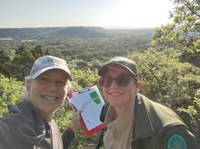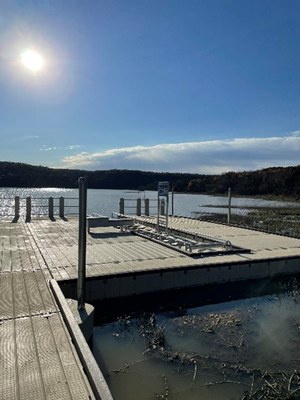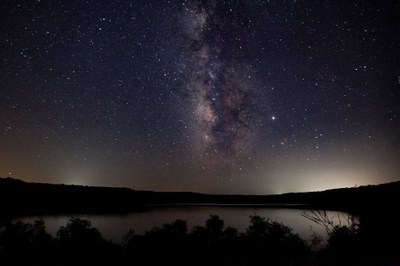Collaboration Through Conflict
June 2025
 by Ranger Kate
by Ranger Kate
We have made a lot of progress over the past couple of months. It’s exciting to see all these projects coming together as the park comes to life. Every aspect has been carefully planned with conservation and accessibility in mind.
Conservation Efforts
We focus on several areas when it comes to conservation. Last month, we wrapped up our first year of surveys on the endangered golden-cheeked warbler. We’ll need a couple more years of data before we have an accurate picture of how these birds use their habitat in our park. For now, we’re looking forward to reviewing this year’s results!
We also discussed the results of our Deer Spotlight Surveys from this past fall. Based on those results, we’re planning to conduct more Deer Spotlight Surveys this coming fall, along with a Browse Survey to learn more about what the herd is eating. Each survey provides different insights. The more data we collect, the better we’ll understand which management strategies will benefit our deer and other wildlife.
Speaking of benefiting wildlife, many anglers will be excited to hear that we’re adding more fish habitat in the coming weeks! We will submerge these artificial structures near our fishing pier and other areas of Lake Tucker. Fish such as bass, crappie, catfish, sunfish, gar and more will have space to hide from predators and ambush prey.
Our fish have been doing very well during construction and haven’t needed restocking. This is a very good thing for future fishermen!
Accessibility Efforts
We are working tirelessly to find ways for a broader range of people to enjoy our park. As mentioned in a previous Ranger Notes, we’ve built special trails and acquired all-terrain wheelchairs to make exploring the outdoors easier for those with varying mobility levels; this includes parents with strollers. Our courtesy dock next to the boat ramp also features an ADA-compliant kayak/canoe launch, making it easier for people of all abilities and experience levels to get on the water.
Thanks to the work done by our friends group, Palo Pinto Mountains State Park Partners, we’ll also be adding a scenic viewer with color-corrective lenses for those with red-green color blindness. We plan to install this viewer on one of our accessible trails overlooking the train tracks and sunset views. These are just a few of the many ways we strive to make our park more inclusive and accessible.
Meeting in the Middle
Most of the time, our conservation and accessibility goals align well. However, we had one situation where these goals clashed slightly: Protecting our starry night sky.
Our team is working on an application to become a Dark Sky Park and collecting readings to assess how dark our night sky is. The application requires us to document and upgrade lighting in the park to be dark-sky compliant. That means using shielded fixtures and/or lower-lumen (warmer color) lights to preserve visibility of the stars. Since we’re currently in the construction phase, these changes are easier to make.
To meet accessibility requirements, certain areas—like main walkways, restrooms and some parking lots—must be well lit at night. Thanks to a collaboration between our Accessibility Team, Natural Resources, and others, we installed lighting that is both dark-sky compliant and accessible. Everyone deserves to marvel at the wonders of the cosmos!
We aim to create a high-quality park for our future visitors while preserving the wild space for the animals that lived here first. We put a lot of effort into every detail. Our current residents and future visitors deserve nothing less! When the day comes and we finally open, I hope our care and attention to these details speaks for itself.




